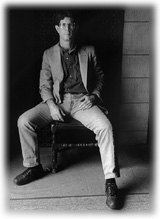Main Menu · Search ·Current Issue ·Contact ·Archives ·Centennial ·Letters to the Editor ·FAQs
 Science
writer Michael Lemonick. EILEEN HOHMUTH-LEMONICK Science
writer Michael Lemonick. EILEEN HOHMUTH-LEMONICK |
When Michael Lemonick '76 was in college, a future that included writing books on astronomy would have seemed a very long shot--especially to his instructors in Physics 12, who nearly failed him. "I have always been interested in science," he says, "and I thought people who liked science became scientists. But choosing astrophysics as my field of concentration ended in a terrible disaster. I didn't have the focus and patience to sit down and do problem sets."
The unexpected setback led to a career crisis from which Lemonick didn't recover until several years out of college. Ultimately journalism occurred to him as a possible way to combine his talents and interests. After hearing the noted writer John McPhee participate in a panel discussion on journalism, Lemonick screwed up his courage, approached the podium, and mentioned his own interest in the field. McPhee ended up hiring him to do some proofreading and later wrote him a letter of recommendation for graduate school, although, Lemonick confesses, "I don't know what he could have said about me, except that I was a great proofreader."
After the Columbia School of Journalism and three years on the staff of Science Digest, Lemonick moved to Time, where he is now a senior writer. His 26 cover stories have ranged from emerging viruses and the ozone hole to diet pills. He keeps up with new developments by reading scientific and medical journals and magazines regularly, attending conferences, and interviewing researchers, and finds his work highly satisfying: "Since science has an enormous impact on people's lives," he says, "I'm able to feel I'm providing a useful service. I'm sort of a translator who takes highly technical jargon and turns it into a form people can understand˜and who explains why it's important."
Despite Physics 12, Lemonick says that astronomy has always remained his first love. His first book, The Light at the Edge of the Universe, came out in 1993; he has now published Other Worlds: The Search for Life in the Universe (Simon & Schuster), a discussion of recent findings in several areas of astronomy. Some of them--such as the possible traces of "biogenic activity" in a meteorite from Mars, the possible existence of water on one of Jupiter's moons, and the discovery of planets orbiting other stars--have made headlines. Lemonick notes he is also concerned to convey "the human aspects of a story as well as the theory, and the satisfaction a researcher feels at unraveling a scientific mystery."
As the father of a 10-year-old daughter, Lemonick says he would like some day to write a series of books about real working scientists for middle-schoolers, to keep their curiosity about science alive. "I was always fascinated by the idea of other worlds out there as a kid," he observes. "And it turns out that astronomers are really asking the very same questions that children ask. The scientists just have to go into some detail to get the answers."
~ Deborah Schneider